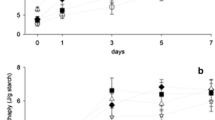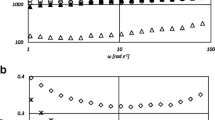Abstract
The use of gluten-free products is increasing since an increasing number of people (1–2 %) are suffering from Celiac disease and thereby need a gluten-free diet. Gluten-free bread tends to have shorter shelf life and quality compared with white wheat bread. In this study, 3 % (flour basis) of pre-gelatinized oat and barley flour as well as an emulsifier were added to a gluten-free mix to increase the water content by 1.5–2 %, affect the starch retrogradation and the formation of amylose lipid complex. The staling was followed measuring the firmness (texture analyzer), water content and distribution (nuclear magnetic resonance), amylopectin retrogradation and the formation of amylose–lipid complex (differential scanning calorimetry) in order to see the impact of both macroscopic and molecular changes on firmness. Both gluten-free bread and a white wheat bread were used as control loaves. Largest specific volume was found in the gluten-free control. The firmness varied with both the specific volume and the point of measurement. The amount of retrograded amylopectin increased the firmness, although this effect was dependent on the type of bread, in terms of distribution and availability of the water within the system. The proton relaxation time, which was representing movable water, decreased during storage and revealed that both the amylopectin retrogradation and the lipid complex formation were affecting the rigidity of the amorphous domain and not only the crystalline regions. In contrast to the other recipes, the use of emulsifier caused limited retrogradation and a low correlation between the texture properties and time-dependent events.









Similar content being viewed by others
References
Mäki M, Mustalahti K, Kokkonen J, Kulmala P, Haapalahti M, Karttunen T, Ilonen J, Laurila K, Dahlbom I, Hansson T, Höpfl P, Knip M (2003) Prevalence of celiac disease among children in Finland. New Engl J Med 348:2517–2524
Lohi S, Mustalahti K, Kaukinen K, Laurila K, Collin P, Rissanen H, Lohi O, Bravi E, Gasparin M, Reunanen A, Mäki M (2007) Increasing prevalence of coeliac disease over time. Aliment Pharmacol Ther 26(9):1217–1225
Lagerqvist C, Ivarsson A, Juto P, Persson LÅ, Hernell O (2001) Screening for adult coeliac disease—which serological marker(s) to use? J Intern Med 250:241–248
Fasano A, Berti I, Gerarduzzi T, Not T, Colletti RB, Drago S, Elitsur Y, Green PHR, Guandalini S, Hill ID, Pietzak M, Ventura A, Thorpe M, Kryszak D, Fornaroli F, Wasserman SS, Murray JA, Horvath K (2003) Prevalence of celiac disease in at-risk and not-at-risk groups in the United States. Arch Intern Med 163:286–292
Tye-Din JA, Stewart JA, Dromey JA, Beissbarth T, van Heel DA, Tatham A, Henderson K, Mannering SI, Gianfrani C, Jewell DP, Hill AVS, McCluskey J, Rossjohn J, Anderson RP (2010) Comprehensive, quantitative mapping of T cell epitopes in Gluten in celiac disease. Sci Transl Med 2(41):41ra51
Montgomery AMP, Goka AKJ, Kumar PJ, Farthing MJG, Clark ML (1988) Low gluten diet in the treatment of adult coeliac disease: effect on jejunal morphology and serum anti-gluten antibodies. Gut 29:1564–1568
Catassi C, Rossini M, Rätsch I-M, Bearzi I, Santinelli A, Castagnani R, Pisani E, Coppa GV, Giorgi PL (1993) Dose dependent effects of protracted ingestion of small amounts of gliadin in coeliac disease children: a clinical and jejunal morphometric study. Gut 34:1515–1519
Alvarez-Jubete L, Auty M, Arendt EK, Gallagher E (2010) Baking properties and microstructure of pseudocereal flours in gluten-free bread formulations. Eur Food Res Technol 230:437–445
Kotoki D, Deka SC (2010) Baking loss of bread with special emphasis on increasing water holding capacity. J Food Sci Technol 47(1):128–131
Correa MJ, Añón MC, Pérez GT, Ferrero C (2010) Effect of modified celluloses on dough rheology and microstructure. Food Res Int 43:780–787
Nishita KD, Roberts RL, Bean MM (1976) Development of a yeast-leavened rice-bread formula. Cereal Chem 53(5):626–635
Demirkesen I, Mert B, Sumnu G, Sahin S (2010) Rheological properties of gluten-free bread formulations. J Food Eng 96:295–303
Mezaize S, Chevallier S, Le Bail A, de Lamballerie M (2009) Optimization of gluten-free formulations for french-style breads. J Food Sci 74(3):E140–E146
Nunes MHB, Moore MM, Ryan LAM, Arendt EK (2009) Impact of emulsifiers on the quality and rheological properties of gluten-free breads and batters. Eur Food Res Technol 228:633–642
Moore MM, Heinbockel M, Dockery P, Ulmer HM, Arendt EK (2006) Network formation in gluten-free bread with application of transglutaminase. Cereal Chem 83(1):28–36
Renzetti S, Dal Bello F, Arendt EK (2008) Microstructure, fundamental rheology and baking characteristics of batters and breads from different gluten-free flours treated with a microbial transglutaminase. J Cereal Sci 48:33–45
Renzetti S, Courtin CM, Delcour JA, Arendt EK (2010) Oxidative and proteolytic enzyme preparations as promising improvers for oat bread formulations: rheological, biochemical and microstructural background. Food Chem 119:1465–1473
Gallagher E, Gormley TR, Arendt EK (2003) Crust and crumb characteristics of gluten free breads. J Food Eng 56(1–2):153–161
Moore MM, Schober TJ, Dockery P, Arendt EK (2004) Textural comparisons of Gluten-Free and Wheat-Based Doughs, Batters, and Breads. Cereal Chem 81(5):567–575
Purhagen JK, Sjöö ME, Eliasson A-C (2008) Staling effects when adding low amounts of normal and heat-treated barley flour to a wheat bread. Cereal Chem 85(2):109–114
Purhagen JK, Sjöö ME, Eliasson A-C (2011) The use of normal and heat-treated barley flour and waxy barley starch as anti-staling agents in laboratory and industrial baking processes. J Food Eng 104:414–421
Purhagen JK, Sjöö ME, Eliasson A-C (2011) Starch affecting anti-staling agents and their function in freestanding and pan-baked bread. Food Hydrocoll 25:1656–1666
AACC International (1983) Approved methods of the American Association of cereal chemists vol method 44-19., 8th edn. Approved Methods of the American Association of Cereal Chemists
AACC (1983) Approved methods of the American Association of Cereal Chemists 8edn. Method 74-09. The Association: St. Paul, MN
Axford DWE, Colwell KH, Cornford SJ, Elton GAH (1968) Effect of loaf specific volume on the rate and extent of staling in bread. J Sci Fd Agric 19:95–101
Knightly WH (1977) The staling of bread. Bakers Digest 51(5):52–56, 144–150
Pisesookbunterng W, D’Appolonia BL (1983) Bread staling studies. I. Effect of surfactants on moisture migration from crumb to crust and firmness values of bread crumb. Cereal Chem 60(4):298–300
Ronda F, Caballero PA, Quilez J, Roos YH (2011) Staling of frozen partly and fully baked breads. Study of the combined effect of amylopectin recrystallization and water content on bread firmness. J Cereal Sci 53:97–103
Krog N, Olesen SK, Toernaes H, Joensson T (1989) Retrogradation of the Starch Fraction in Wheat Bread. Cereal Foods World 34(3):281–285
Krog N (1977) Functions of emulsifiers in food systems. J Am Oil Chem Soc 54:124–131
Arendt EK, Morrissey A, Moore MM, Dal Bello F (2008) Gluten-free breads. In: Arendt EK, Dal Bello F (eds) Gluten-free cereal products and beverages, pp 289–319, VII
Gil MJ, Callejo MJ, Rodríguez G (1997) Effect of water content and storage time on white pan bread quality: instrumental evaluation. Z Lebensm Unters Forsch A 205:268–273
D’Appolonia BL, Morad MM (1981) Bread staling. Cereal Chem 58(3):186–190
Ottenhof M-A (2003) A multi-technique study of the retrogradation of concentrated starch systems. University of Nottingham
Chen PL, Long Z, Labuza TP (1997) Nuclear magnetic resonance studies of water mobility in bread during storage. Lebensm-Wiss u-Technol 30(2):178–183
Engelsen SB, Jensen MK, Pedersen HT, Nørgaard L, Munck L (2001) NMR-baking and multivariate prediction of instrumental texture parameters in bread. J Cereal Sci 33:59–69
Ribotta PD, Cuffini S, León AE, Añón MC (2004) The staling of bread: an X-ray diffraction study. Eur Food Res Technol 218:219–223
Acknowledgments
The authors wish to thank Val Street for performing the DSC-measurements and Imad Farhat for all the valuable help with the interpretation of the NMR results. Financial support was obtained from the Marie Curie Foundation, Sparbanksstiftelsen Färs & Frosta and Formas.
Author information
Authors and Affiliations
Corresponding author
Rights and permissions
About this article
Cite this article
Purhagen, J.K., Sjöö, M.E. & Eliasson, AC. The anti-staling effect of pre-gelatinized flour and emulsifier in gluten-free bread. Eur Food Res Technol 235, 265–276 (2012). https://doi.org/10.1007/s00217-012-1753-4
Received:
Accepted:
Published:
Issue Date:
DOI: https://doi.org/10.1007/s00217-012-1753-4




